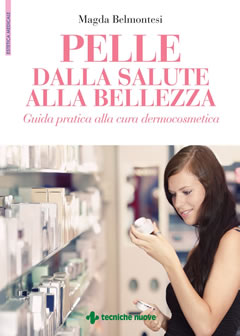Area riservata
Sezioni di pelle

Pelle dalla salute alla bellezza. Guida pratica alla cura dermocosmetica.
Ora disponibilie su: Amazon
Links
Dott.ssa Maria Gabriella di Russo
Medico Chirurgo
Specialista in Idrologia Medica
www.mariagabrielladirusso.it
Medico Chirurgo
Specialista in Idrologia Medica
www.mariagabrielladirusso.it

Novità, anticipazione, notizie dal mondo dei filler e dei più innovativi trattamenti estetici....
Per saperne di più - Il mondo di Restylane
Cosmeceuticals: a new page for the skin

The term cosmeceutical comes from the fusion of cosmetic and pharmaceutical and means a number of molecules representing the middle course between the two preparations, as they are stronger than a normal cosmetic though not being a medicine. Actually, in cosmetologic chemistry this category doesn’t exist at all because a product either is a medicine (therefore it may be prescribed only by a doctor and must be approved by the Ministry through the specific procedure for pharmaceutical products) or a cosmetic, then with no need of medical prescription but with the support of a particular scientific documentation to be submitted according to the most recent EEC norms; therefore, the denomination comprehends both concepts. Certainly this new ”family“ is particularly rich, above all in components that actively contrast skin aging, both chronological (chrono-aging) and induced and worsened by photodamaging due to exposure to UV rays (photo-aging). Some of these principles are really very efficacious, and their potentiality is higher than a normal cosmetic, but a clear and scientific official classification on the matter doesn’t exist yet.
A PROFITABLE UTILIZATION
The complete list of the substances that can be considered as belonging to the family of cosmeceuticals would be certainly very long and, above all, it should be continually updated. For this reason we’ll take into consideration the main cosmeceuticals and/or active principles that presently are at most widely used. The AHAs, for instance, and first of all the glycolic acid, that can be considered as the cosmeceutical par excellence: its activity is connected to the ability of removing from the skin, with different strength according to its concentration and its acidity degree, the cells of the superficial layer with keratolytic effect, by deeply stimulating a renewed impulse to reactivate the regeneration of basal epidermic cells. Talking about cosmeceuticals, besides fruit acids we certainly find also vitamins that, thanks to their strong antioxidant action, are as much indispensable to contrast the formation of free radicals representing some of the main enemies of our skin’s and organism’s youth. In particular, we can talk about retinol/vitamin A that carries out a smooth peeling action, a valid antiradical activity and an important protective function for epithelium (we must rememeber that histologically skin is a stratified pavement epithelium). Retinol must not be confused with retinoic acid (known also as acid vitamin A) that also belongs to the class of retinoids, but in this case it is a medicine, with precise indications as concerns acne and damages due to solar radiations. Nevertheless, it must be always prescribed by a doctor because, like all medicines, it may have collateral effects such as skin dryness, eventual flushings and phenomena of sun photosensitization.
Vitamin C represents the new entry in the cutaneous local utilization because its molecule inactivates easily: for this reason the cosmetologic science succeeded only not long ago in keeping valid its efficacy in creams and similar formulations. Vitamin C is a strong antioxidant both for the epidermis, thanks to its ability to protect the cellular integrity, and for the derma with protection of collagen fibers.
Moreover, its efficacy spreads also to small blood capillaries, making them stronger and less breakable and it carries out a considerable lightening action giving brightness to the skin. In the field of antioxidants we also find the coenzyme Q10 that, created as a medicine for the cardiac protection, at the present is widely used in cosmetology thanks to its strong capacity not only to neutralize free radicals but, above all, to favour the self-repair of cells damaged by oxidation.
In conclusion, the latest antioxidant is lipoic acid, considered a wide spectrum antioxidant able to work with the same strength both against water-soluble radicals and against lipid-soluble radicals (namely skin, from the superficial hydrolipidic film to the cellular composition itself, consists completely of an alternation of water and lipids), thus assuring a very high antiradicalic protection. Furthermore, the utilized lipoic acid is obtained in the laboratory through processes of technological biosynthesis, keeping the same characteristics of the endogenous acid normally present in our body. In fact, in our body the lipoic acid allows the cell to spend energy through the transformation of glucose into pyruvic acid during the metabolic processes, working as an energetic “booster”. Its precious qualities are linked to the action binomial between lipoic acid and dehydrolipoic acid that, besides inhibiting the formation of the most important kinds of free radicals, is able to chelate bivalent metals that may represent an arising factor of the oxydative process. The two active principles are able as well to regenerate the endogenous antioxidant pool of our body represented by natural vitamins (vitamin C, vitamin E, glutathione), thus strengthening farther on the antiradicalic action.
Hyaluronic acid is certainly the most used molecule thanks to its different utilization from cosmetology to aesthetic medicine. Its success comes mainly from its molecular characteristics normally present on the derma. It is a GAG (abbreviation for glycosaminoglycans, responsible for giving support and deep moisture to skin), that means a very large and heavy molecule. Just because of this structure, we can imagine hyaluronic acid as a kind of big sponge able to absorb and release water in huge amounts according to the local need and also to carry out an antioxidant action inhibiting the oxidative stress.
Then, cosmeceuticals, some of which have been here briefly analysed, are valid and efficacious principles able to help us daily to keep and care our skin’s health and beauty. Their proper utilization, according to the different aesthetic/corrective needs, certainly improves and helps to prevent the damages of skin aging.
A PROFITABLE UTILIZATION
The complete list of the substances that can be considered as belonging to the family of cosmeceuticals would be certainly very long and, above all, it should be continually updated. For this reason we’ll take into consideration the main cosmeceuticals and/or active principles that presently are at most widely used. The AHAs, for instance, and first of all the glycolic acid, that can be considered as the cosmeceutical par excellence: its activity is connected to the ability of removing from the skin, with different strength according to its concentration and its acidity degree, the cells of the superficial layer with keratolytic effect, by deeply stimulating a renewed impulse to reactivate the regeneration of basal epidermic cells. Talking about cosmeceuticals, besides fruit acids we certainly find also vitamins that, thanks to their strong antioxidant action, are as much indispensable to contrast the formation of free radicals representing some of the main enemies of our skin’s and organism’s youth. In particular, we can talk about retinol/vitamin A that carries out a smooth peeling action, a valid antiradical activity and an important protective function for epithelium (we must rememeber that histologically skin is a stratified pavement epithelium). Retinol must not be confused with retinoic acid (known also as acid vitamin A) that also belongs to the class of retinoids, but in this case it is a medicine, with precise indications as concerns acne and damages due to solar radiations. Nevertheless, it must be always prescribed by a doctor because, like all medicines, it may have collateral effects such as skin dryness, eventual flushings and phenomena of sun photosensitization.
Vitamin C represents the new entry in the cutaneous local utilization because its molecule inactivates easily: for this reason the cosmetologic science succeeded only not long ago in keeping valid its efficacy in creams and similar formulations. Vitamin C is a strong antioxidant both for the epidermis, thanks to its ability to protect the cellular integrity, and for the derma with protection of collagen fibers.
Moreover, its efficacy spreads also to small blood capillaries, making them stronger and less breakable and it carries out a considerable lightening action giving brightness to the skin. In the field of antioxidants we also find the coenzyme Q10 that, created as a medicine for the cardiac protection, at the present is widely used in cosmetology thanks to its strong capacity not only to neutralize free radicals but, above all, to favour the self-repair of cells damaged by oxidation.
In conclusion, the latest antioxidant is lipoic acid, considered a wide spectrum antioxidant able to work with the same strength both against water-soluble radicals and against lipid-soluble radicals (namely skin, from the superficial hydrolipidic film to the cellular composition itself, consists completely of an alternation of water and lipids), thus assuring a very high antiradicalic protection. Furthermore, the utilized lipoic acid is obtained in the laboratory through processes of technological biosynthesis, keeping the same characteristics of the endogenous acid normally present in our body. In fact, in our body the lipoic acid allows the cell to spend energy through the transformation of glucose into pyruvic acid during the metabolic processes, working as an energetic “booster”. Its precious qualities are linked to the action binomial between lipoic acid and dehydrolipoic acid that, besides inhibiting the formation of the most important kinds of free radicals, is able to chelate bivalent metals that may represent an arising factor of the oxydative process. The two active principles are able as well to regenerate the endogenous antioxidant pool of our body represented by natural vitamins (vitamin C, vitamin E, glutathione), thus strengthening farther on the antiradicalic action.
Hyaluronic acid is certainly the most used molecule thanks to its different utilization from cosmetology to aesthetic medicine. Its success comes mainly from its molecular characteristics normally present on the derma. It is a GAG (abbreviation for glycosaminoglycans, responsible for giving support and deep moisture to skin), that means a very large and heavy molecule. Just because of this structure, we can imagine hyaluronic acid as a kind of big sponge able to absorb and release water in huge amounts according to the local need and also to carry out an antioxidant action inhibiting the oxidative stress.
Then, cosmeceuticals, some of which have been here briefly analysed, are valid and efficacious principles able to help us daily to keep and care our skin’s health and beauty. Their proper utilization, according to the different aesthetic/corrective needs, certainly improves and helps to prevent the damages of skin aging.















